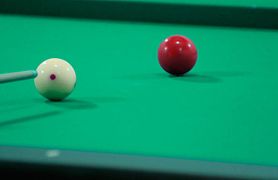Billiard ball

As a billiard ball or billiard ball is called the game object when billiards . Basically, a distinction is made between game balls that may be touched with the cue and object balls that may not be touched with the cue. The number, color and size vary in the various disciplines.
history
The earliest balls for the game of billiards were made of ivory , but this had disadvantages. The balls wore out quickly, regrinding was necessary and the diameter and circumference changed. In addition, the behavior of the spheres could not be calculated because ivory, as a natural raw material, has differences in density. Another disadvantage was the limited availability of ivory, which resulted in high raw material prices.
In 1863 Michael Phelan advertised a $ 10,000 prize for an alternative to the ivory ball. In 1869, finally found John Wesley Hyatt with celluloid a thermoplastics that met the requirements and has been improved over time.
Today billiard balls are made from high-purity phenolic resin . The market leader is the Belgian company Saluc , which sells its material under the name Aramith . Compared to ivory balls, modern plastic balls have much better rolling properties and are also more resistant. The collision discipline art push was an exception . There the ivory balls were used regularly until the 1960s because of their better spin properties for massé shocks. They were last used at the 1986 European Championships. There, the 7-time German champion Gert Tiedtke broke an ivory ball in half during one of his attempts to hit it.
Balls at pool
The balls at pool are numbered and precisely defined in terms of color. In addition to the white cue ball, there are 15 object balls. A pool ball has a diameter of 57.2 mm and weighs 170 g.
The balls with the numbers 1 to 8 are also referred to as the full ones and the balls 9 to 15 as the halves , since the latter are only half colored. The following colors are assigned to the numbers:
- 1/9 = yellow
- 2/10 = blue
- 3/11 = red
- 4/12 = purple or pink 1
- 5/13 = orange
- 6/14 = green
- 7/15 = wine red
- 8 = black
- Match ball: white or white with red dots 1
1 There are differences between normal ball sets and the TV set, in which the colors differ slightly from the original colors in order to make them easier to see on TV. Match balls with red dots convey the spin used better to the audience .
Balls in snooker
In addition to the white cue ball, there are 21 object balls in snooker . The balls in snooker have different values depending on their color. Each of the 15 reds scores one point, while the other, unique colors, score between two and seven points. As colored balls in snooker all non-red object balls are called. A snooker ball has a diameter of 52.5 mm with a tolerance of +/- 0.05 mm. It weighs between 130 and 150 g, whereby the difference between the lightest and the heaviest ball in a set must not be greater than 3 g.
- Red = 1 point
- Yellow = 2 points
- Green = 3 points
- Brown = 4 points
- Blue = 5 points
- Pink = 6 points
- Black = 7 points
Balls in a collision
In carom billiards , in most disciplines there are only two game balls (one for each player or team) and one red object ball, called a carambola . In the past, both game balls were white and provided with inconspicuous markings, but in the meantime, for reasons of clarity, they have switched to playing with a white and a yellow ball. As mentioned above, these are provided with red dots to better illustrate the spin. In a modified version there is also a fourth, blue ball. At 61.5 mm (weight approx. 205 to 220 g), carom balls are larger than pool and snooker balls. Only the balls in Russian billiards are bigger .
Russian billiard balls (pyramid)
With a diameter of 68 mm (weight approx. 204 g), the balls in Russian billiards are the largest and heaviest balls in billiards. There is a red bump ball and 15 numbered, white object balls. After the kick-off, the red ball also becomes the object ball and the whites become push balls (free choice!). Since the pockets are only a few millimeters larger than the balls, they are considered difficult to punch.
Web links
- About billiard balls on the website of Saluc , the market leader in billiard balls (mostly in English)
Individual evidence
- ↑ Did you know ...? BSC Girbelsrath, archived from the original on December 7, 2015 ; Retrieved April 10, 2017 .







